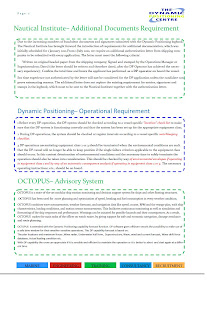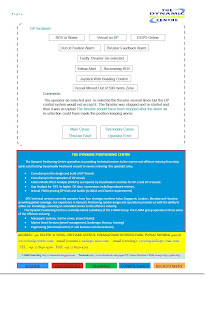DP Training at C-MAR Centres are now globally recognised as the first port of call for DP training and skills. We have raised the bar in recent years by offering tailored DP courses that address specific needs within the industry. Operating at a level well above international standards means that we are committed to providing excellence in DP instruction from contemporary facilities around the globe.
Setting The Standards

Friday, December 2, 2011
Thursday, November 3, 2011
Monday, October 3, 2011
Thursday, September 1, 2011
Monday, August 1, 2011
Sunday, July 3, 2011
Wednesday, June 1, 2011
Friday, May 6, 2011
Friday, April 1, 2011
Friday, March 4, 2011
Thursday, February 3, 2011
Offshore beckons, and many are attracted . If you happen to be one of them then DP is the gateway to a career in offshore, as most of the offshore vessels are getting equipped with DP system.
After working in DP field for a decade and teaching at various DP training centers, I have come across a number of seafarers who had many queries about DP. These questions range from simply knowing about DP, prevailing working conditions in offshore, pay & perks to more career oriented queries such as promotional prospects and certification etc. It will be my endeavor to satisfy some of these queries in the succeeding paragraphs.
Dynamic Positioning in the offshore industry, is not new as it came into being in the year 1961, but its only from 1977 that technical advancements brought in the high accuracy in position-keeping, which in turn increased the usability and importance of DP in the offshore industry. These days, a DP vessel operating as close as 10m from a platform, can reliably maintain position within a meter of excursion thus helping in various offshore operations which require high level of accuracy. DP is regularly being used in offshore vessels like offshore support vessels (OSV), diving support vessels (DSV), heavy lift cranes, construction vessels, drilling ships , survey vessels, pipelay vessels and many others. As a matter of fact these days DP is even being installed in larger passenger vessels, tankers, dredgers etc. for quick maneuverability and navigation in restricted waters. This does away with the requirement of tugs and pilots to come alongside.
In DP , position-keeping is done with the help of thrusters, arranged in longitudinal and athwart ship direction, controlling all the three axes of movement i.e. surge, sway and yaw. A DP vessel has inherent advantage over the conventional mooring type vessel as it doesn’t require assistance of tugs to take position. It can change position quickly and is capable of working in deep as well as shallow waters. Dynamic Positioning is done with the help of a central computer which controls all the thrusters depending upon the input it receives from reference systems and gyro. It is also helped by a ‘software model’, which maintains memory of the environmental forces acting on the vessel. During the DP mode, it is totally hands-off and requires operator’s intervention only on failures. In addition, a joystick is provided to manually control all the thrusters collectively in the desired direction. To run so many thrusters, a large numbers of generators and control systems are fitted on the ship, keeping the ETO and the Chief Engineer busy.
Life onboard a DP (offshore) vessel is quite different from that of a main fleet vessel. Generally, watches are of 12 hours in two watch system. On a typical OSV, vessel is expected to visit as many as 5-6 platform a day to deliver / receive cargo and enter the nearest port to top-up every week. There is never a moment of monotony or inactivity. Due to the smaller size of vessel, say a length of 60-70m for an OSV, more rolling and pitching in the rough seas is experienced. Shorter contracts of 6-8 weeks, extra money and better living conditions make up for that bit of discomfort. Since most of the offshore vessels operate in the same field for longer period, so there is less hassles associated with port state control inspections , planning of voyages and pollution control. Some of the DP vessels like drill ships, hardly change location over a prolonged period! Same set of crew regularly working on the same vessel is one of the biggest benefit that offshore industry enjoys. Owners are happy as the vessels are maintained well and crew is more comfortable in the known surrounding.
DP vessels are categorized in Class 1, 2 &3. In most simple terms, classification is based on redundancy of equipment. Therefore, hazardous jobs are assigned to higher class of vessels. For example, a Diving Support Vessel (DSV) will be a Class2/3, whereas, a vessel employed in clear area could be Class1.
DP training for the deck officers is based on the Nautical Institute scheme all over the world. A complete scheme is shown in the box. A 4-day Basic (Induction) Course followed by 30 days sea-time on a DP vessel, after which a 4-day Advanced(Simulator) course followed by six months sea time , will qualify a seafarer for a DP certificate. Six months sea-time on a Class1 vessel will qualify a seafarer for a ‘restricted certificate’. To qualify for a full DP license , one need to work on a Class 2 vessel for a minimum two months. The certification is subject to successful completion of NI logbook. The Nautical Institute is improving its services to facilitate DPOs to apply, track and pay online for their certificate with effect from January 2011. There are many DP training institutions all over the world providing training based on the NI scheme. Some run 5-day courses, while others have 4-day courses but meeting the same standard set by the Nautical Institute. The Basic Course imparts a detailed theoretical knowledge whereas Advanced Course deals with the planning and execution of different types of DP operations and handling DP emergencies. Similarly, for engineers, a 4-day Maintenance course, is designed to give the requisite knowledge to work onboard. Appreciation Courses of duration (1 /2 day) are offered to industry to promote awareness among onshore managers, owners and clients.
Fresh entrants are advised to complete their mandatory trading vessel time before joining DP courses. Assessment of sea-time has been clarified in the NT Wing/Exam Circular 01 of 2009 and 02 of 2010. There is no minimum qualification for doing DP courses. It is quite acceptable in many countries for non-mariners to qualify as DPO. Since many DP platform do not navigate like FPSOs , they do not necessarily require the marine background. In Indian scenario, however, non-mariners may not find suitable employment. Interestingly, pay and perks in offshore draws maximum enquiry. Rank to rank a DPO may draw as much as 20-50% more than his counterpart. It cannot be quantified as it changes substantially in international market and from region to region.
Seafarers planning to change their stream are advised to take free counseling available by experienced old hands at The DP Centre. The next step would be to look for a potential employer, the list of which could be obtained for reference. A high quality international level DP training in the two most widely used DP systems, Kongsberg and Converteam, imparted by internationally exposed instructors ,will make you competent enough to get the best jobs. The DP Centre collectively trains over 40% of NI certified DP Operators worldwide. The C-MAR group has a large pool of technical experts regularly conduct trials and high end technical work relating to DP and other offshore activities internationally.
Capt KC Shukla is the Senior Lecturer with The DP Centre since 2008. He has taught at Singapore, and |
Subscribe to:
Comments (Atom)






























